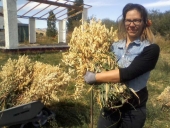
 13
13




 1
1




SKIP books, get 'em while they're hot!!! Skills to Inherit Property
 5
5




 1
1





SKIP books, get 'em while they're hot!!! Skills to Inherit Property
 1
1




No man is an island.




Come join me at www.peacockorchard.com
 1
1




James 1:19-20
Not all those who wander are lost - J. R. R. Tolkien
 2
2




Mike Jay wrote:Simple is good, tons of little moving parts is bad. As long as it works

What acreage range are you aiming this machine towards?
 3
3








SKIP books, get 'em while they're hot!!! Skills to Inherit Property




Travis Johnson wrote:The biggest issue I have now with my thresher design is slowing down some of the motors. To have variable speed control would be ideal, as I could fine tune everything on the go for various field conditions...
Direct current electric motors would work well because they can be slowed down easily, but that would require a direct current generator, and I could not find any the size I would need.
James 1:19-20
Not all those who wander are lost - J. R. R. Tolkien




Mike Jay wrote:If you're just going to build a prototype, they have overstock gear motors on Surplus Center. But as a farmer, you probably have access to all kinds of motors and equipment...




Caleb Mayfield wrote:Do you think you would be able to build your own generator as a proof of concept using an engine and one or more high amp alternators with a small battery bank to provide sufficient choochification? It would be a way to use off the shelf parts that would get a system running, and potentially lead to so custom produced parts if needed.
 2
2




 ) efficiency out of it. There's a connection between the size of the motors and the efficiency. I think I recall the going bigger was more efficient. There's lots of good info out there on the calculations and the practicalities for a home brew. If you want to get into that. Must be commercial offerings, but I don't know what the price on those might be. Maybe in the end be better to get a 3-phase genset. The info is out there but there's lots of electrical magic needed as well as mechanical fabrication.
) efficiency out of it. There's a connection between the size of the motors and the efficiency. I think I recall the going bigger was more efficient. There's lots of good info out there on the calculations and the practicalities for a home brew. If you want to get into that. Must be commercial offerings, but I don't know what the price on those might be. Maybe in the end be better to get a 3-phase genset. The info is out there but there's lots of electrical magic needed as well as mechanical fabrication.












 1
1



















Rufus Laggren wrote:> 3-phase
Converting 1 to 3-phase needs, IIRC, a 3-phase motor which is powered by the 1-phase and puts out 3-phase. Roughly speaking. Been 10 years since I considered adding 3-phase to my shop and I never got around to it; the details have gone and slipped. I think I was looking a 10hp motor for the converter to run 3-5hp 3-phase in the shop. Not pocket sized but maybe you'e dealing with a chassis large enough to take it in stride. Again, IIRC, you get 70% () efficiency out of it. There's a connection between the size of the motors and the efficiency. I think I recall the going bigger was more efficient. There's lots of good info out there on the calculations and the practicalities for a home brew. If you want to get into that. Must be commercial offerings, but I don't know what the price on those might be. Maybe in the end be better to get a 3-phase genset. The info is out there but there's lots of electrical magic needed as well as mechanical fabrication.
Rufus












Nails are sold by the pound, that makes sense.
Soluna Garden Farm -- Flower CSA -- plants, and cut flowers at our Boston Public Market location, Boston, Massachusetts.





|
I don't even know how to spell CIA. But this tiny ad does:
A rocket mass heater heats your home with one tenth the wood of a conventional wood stove
http://woodheat.net
|

